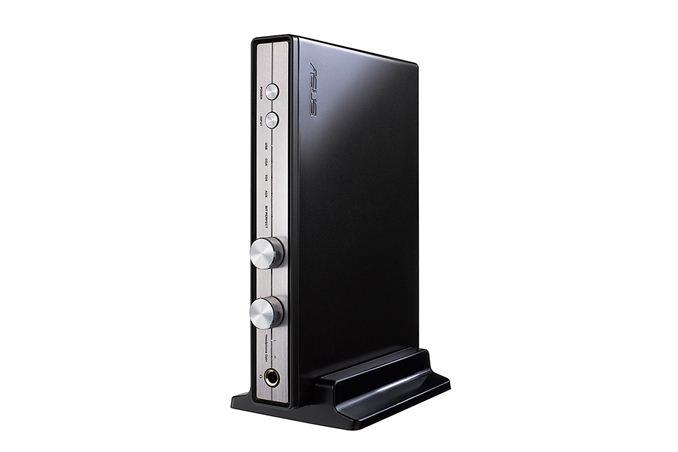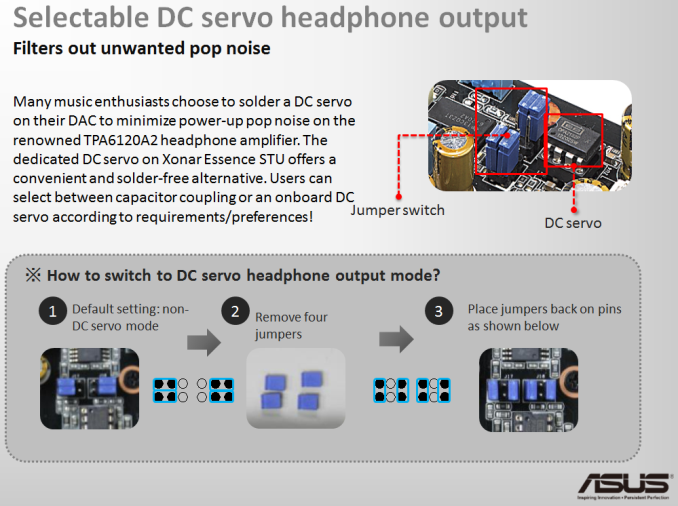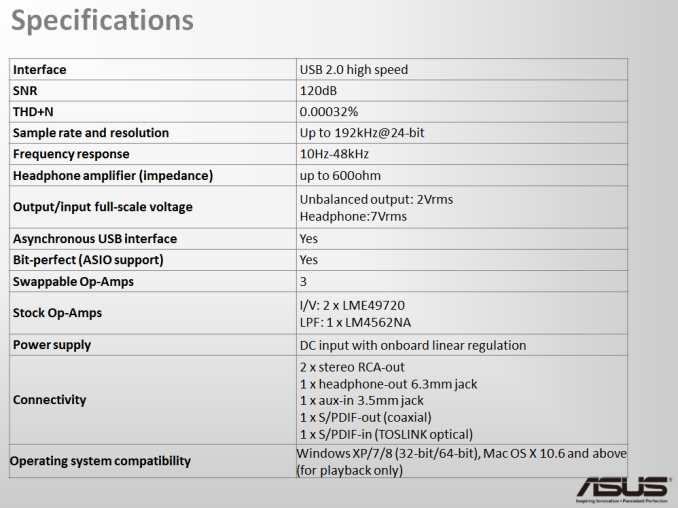ASUS Launches Xonar Essence STU USB DAC
by Ian Cutress on October 21, 2013 5:03 AM EST
One of the stalwarts of ASUS' audio program has been the Xonar Essence ST/STX sound cards - these are sound cards with a multi-year development cycle to ensure compatibility, usability and getting exactly down to the nitty-gritty of what a user requires. On the back of the success of the Xonar Essence range, ASUS are launching the Xonar Essence STU device - a USB digital to analog converter and headphone amplifier, based on the Xonar Essence ST/STX design.
Features include 120+ dB signal-to-noise ratio (DAC is rated at 127 dB SNR), 0.00032% THD+N, swappable op-amps, a 600 ohm headphone amplifier and segregated PCB layout to minimize signal interference and crosstalk.
To cater for audiophiles the system is adjustable via Op-Amps, selectable DC servo headphone output, a volume bypass mode (to use the STU as a pre-amplifier) and variable resistor calibration for optimization of left/right channel outputs.
The Xonar Essence STU is due for release in North America in the next two weeks, MSRP of $399. Other markets to follow.


















23 Comments
View All Comments
Impulses - Monday, October 21, 2013 - link
I agree, I bought an STX because of the value proposition. At $160 on sale (or even the MSRP of $200) it's a pretty solid value compared to most discrete amp/DAC solutions. It won't beat something like a Schiit Magni/Modi for the price (and the 10ohm output impedance is iffy with many low impedance headphones) but it'll come pretty close while being an internal solution and also providing Dolby Headphone. If you don't care about DH processing you're better off looking at stuff like the O2/ODAC, Magni/Modi, etc. At $400 this competes with a higher class of audiophile products.ninjaquick - Tuesday, October 22, 2013 - link
This is a stereophile device. There are other products for Surround enthusiasts, but those are far less relevant as most Audiophiles don't care about reproduction of surround sources, as most surround sources push most content to center/FL/FR channels, leaving all other channels for strictly surround cues.maecenas - Monday, October 21, 2013 - link
I've really enjoyed my ST card from Asus, great to see they're providing the same card in an external USB format, but I don't see what justifies this being twice as expensive as the ST/STX cards.extide - Monday, October 21, 2013 - link
I have said this before and I will say it again. I will only be interested when they stop using off the shelf IC headphone amps. Build a proper discreet amp, then you are talking. At least it is using a burr-brown DAC, but I am a little bit partial to wolfson these days, but that's just me. I am sick of seeing that TI TPA6120A amp though!!!extide - Monday, October 21, 2013 - link
I forgot to add, the rest of it looks pretty well done though. I like the ability to bypass all amp circuitry and use it as just a DAC, and the rollable op-amps is a nice touch as well. They are definitely on the right track here, just get rid of that damn TPA6120 and I will be a lot happier.extide - Monday, October 21, 2013 - link
God I didn't see the price! I currently run an ODAC + JDS Labs C421 HP Amp, and together they are cheaper than this thing's MSRP!moriz - Monday, October 21, 2013 - link
http://nwavguy.blogspot.ca/2011/08/op-amps-myths-f...sounds like a discrete amp is exactly something that you DON'T want.
extide - Monday, October 21, 2013 - link
That guy knows his stuff for sure, but he is talking about going discreet to the point where you arent even using op amps, I wasn't really talking to that extent, just getting rid of the single-chip solution, and moving to something with individual opamps, caps, etc. I should have been more clear, I can see how that could have been taken the wrong way.johan851 - Monday, October 21, 2013 - link
Having read a lot of that guy's stuff, I'd say he knows enough to be dangerously misleading. Yes, everything in that article is true, but he adds a heavy spin by leaving out quite a bit of important information. He tends to focus only on the point he wants to prove (like discrete is worse) before he writes the article, then goes about finding information to back his point up.The opamp used for headphone amplification here is designed to be an output stage, and has built in output buffers. Typically opamps won't have this, as they're not optimized for use as an output stage and don't do a good job of current delivery into demanding loads. Headphones usually aren't very demanding, so you'll still see designs out there with opamp output stages. They're typically inexpensive, simple, and sound fine given those constraints as long as the load isn't too demanding. nwavguy doesn't mention this limitation.
This particular amplifier opamp is a monolithic amp solution, so it designed to be used as an output stage and has built in buffers. That's a good start. The 13ohm output impedance (according to the datasheet) is... not so great. It tells you that the amp is going to struggle to produce clean output in demanding situations (and again, headphones aren't typically super demanding). There are a lot of benefits to non-discrete designs, including those things mentioned in nwavguy's article, but he doesn't mention one other important metric opamps are optimized for: cost. The TPA6120 chip mentioned here is a $5 part. That's not good or bad in itself, but it tells you what that this USB DAC is also optimized for cost. To some extent you get what you pay for, and I would say that this output stage is a *great* deal at $5. It's a very simple solution that'll sound better than anything you could build to replace it for up to $20 or so.
Then you see the price tag of the DAC, and it makes you wonder where that $400 MSRP is going. :) I think that's what extide is getting at; the MSRP of this product, for what you're getting, is ridiculous. For $400, I would expect more than a $5 output stage. Replacing that output opamp with a discrete output stage (and opamps as the gain stage would still be good choice in this situation) would have the following tradeoffs:
- higher cost
- larger parts (good output transistors are necessarily large)
- much better output impedance, meaning better current driving ability
- more complex circuit design
I would expect a $400 product to make those tradeoffs for quality rather than opting for the very inexpensive, simple single-chip design they did.
johan851 - Monday, October 21, 2013 - link
Correction - that blog post does mention that opamps aren't good at driving difficult loads.